Day Trips By Train
Totnes with steam train to Buckfastleigh plus bus to Dartmouth
| Plymouth | A walk to Cothele from Calstock Station | Saltash | St Germans | Looe | Menheniot | Liskeard | Bodmin Steam Railway and Lanhydrock House | Lostwithiel | Par | St Austell | Truro | Redruth | Camborne | Hayle | St Erth | PenzanceFor a comprehensive selection of days out by train, please read below or for train times visit our Transport page.
Day trip to Totnes with steam train to Buckfastleigh
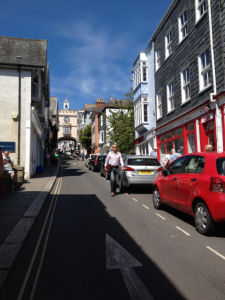 Totnes is a quirky character filled riverside town with Friday antiques, food and curio market. Heralded as a transition town, it has all the loveliness you might expect of a well heeled hippy town. In November and December on Tuesday evenings there is a vibrant street craft market with live music. Totnes is also home to an annual street entertainment and buskers competition.
Come to Totnes for independent shops, handmade shoes, vibrant cafes serving a range of ethical and home made food and drink. Totnes Castle - is one of the best surviving
examples of a Norman mote and bailey castle and has commanding views of Totnes, the river Dart and the surrounding countryside. The footpath to the town centre from the station takes you past the castle entrance.
Totnes is a quirky character filled riverside town with Friday antiques, food and curio market. Heralded as a transition town, it has all the loveliness you might expect of a well heeled hippy town. In November and December on Tuesday evenings there is a vibrant street craft market with live music. Totnes is also home to an annual street entertainment and buskers competition.
Come to Totnes for independent shops, handmade shoes, vibrant cafes serving a range of ethical and home made food and drink. Totnes Castle - is one of the best surviving
examples of a Norman mote and bailey castle and has commanding views of Totnes, the river Dart and the surrounding countryside. The footpath to the town centre from the station takes you past the castle entrance.
South Devon Steam Railway - (01364 644370) is a short walk from Totnes station - follow the signs from the down side station building.
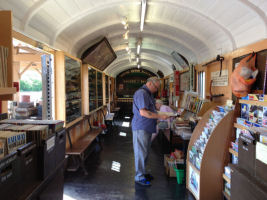
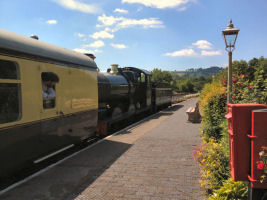
On average between April and October there are 3 trains each way between Buckfastleigh and
Totnes. Trains may not run every day - check the timetable first. The journey time is 25 minutes.
Worth checking out on route is Staverton (10 minutes from Totnes), an idyllic country station
with river and woodland walks. The village with its 14th century church and village inn is
about twenty minutes walk from the station.
At Buckfastleigh there is a Butterfly Garden & Otter Sanctuary and a combined ticket is
available for the train and attractions.



The Butterfly Garden has exotic butterflies and moths from around the world free flying in a
tropical landscaped garden where birds, fish and terrapins can also be found. There are
three different species of otter alongside the native British otter in the sanctuary.
In July & August a vintage bus ferries train passengers from Buckfastleigh
station to Buckfast Abbey. Again, a combined train & bus ticket is available.
Dartmouth
It is also possible to catch a bus to Dartmouth from Totnes, taking a ride through steep rolling red hills. Dartmouth is the destination for the Paignton steam railway, and from here you can catch a boat and steam train back to Paignton and then jump on the branchline to Newton Abbot.

Plymouth
Plymouth, aptly crowned Britain’s Ocean City, has pockets of beauty and sweeping views across the bay to Drakes Island and beyond. The city centre was demolished in the Second World War, and was rebuilt in a very modern way, making navigation easy. We've divided our suggestions into categories to make planning your trip easier.
Shopping
Head downtown towards Frankfurt Gate for the independent quarter; cheap charity shops, world food emporiums and Plymouth Market, which is a great place to buy fresh fruit and veg or a cheap watch, or go uptown to the impersonal Drakes Circus, with its noisy big-names mall. The Barbican is the place for antique and artisan; stop and admire state of the art modern design at Victoria Sewart Jewellery.
Architecture and Sightseeing
Plymouth is much more than a shopping destination.
For a great guide to Plymouth’s iconic architecture, we recommend Eye Traveller’s Plymouth: the architecture tour.
In the centre of Plymouth opposite the university and just below the old library is the newly built Plymouth Museum, known as The Box. This is a superb place, fully accessible, free entry, with cafe and changing exhibitions. We would consider this a must for anyone visiting Plymouth, and a perfect place to while away a rainy day.
The Hoe and The Barbican
If you do nothing else, make sure you include the Hoe, with its stunning views, iconic Smeaton’s Tower and Lido (seasonal). From there walk to the ancient Barbican, famous for the Mayflower Steps, where the Pilgrim Fathers left for their trip to America.
The Hoe sweeps gracefully along the shore front of Plymouth and from here you can see Drake’s
Island (which can be reached during Summer months by a boat ride from the Barbican).
The first thing to watch out for as you enter the Barbican from the Hoe direction are the Mayflower Steps, from which the Pilgrim fathers set off on their journey to America. Near here also is the Barbican Glassworks, a converted fish market with glassworks and high quality gift shops. A bridge near the glassworks leads across the water to the National Marine Aquarium, a wonderful attraction for all weathers, award-winning, eco-friendly and completely accessible.
The Barbican, has a glut of interesting galleries, antique and craft shops, and plenty of places to eat, including the famous out door cafe Captain Jaspers, just behind the Glassworks. The artist
Robert Lenkiewicz had his studio and gallery on the harbour side just behind the main street. Following Lenkiewicz's death in 2005 the gallery remains open and continues to display his work. Other famous Plymouth artists associated with the Barbican include Beryl Cook and Brian Pollard.
Heading towards the Barbican, an excellent place to eat is the vegan cafe Cosmic Kitchen, which is a great favourite of ours. It's quite tricky to find, sandwiched behind the magistrates court in the area behind the grand Plymouth Guildhall. They have regular live music nights at the weekend, and a popular Sunday roast.
Other good eateries and pubs in the Barbican area include the traditional Dolphin Pub,
Heading back into town The Minerva is a great locals pub, with real ales and live music.
Two miles out of the centre is The Royal William Yard, which is served by buses from Plymouth centre. This is a grand ex-military compound, filled with artists studios, smart eateries and a monthly market. From here you can catch the Cremyll Ferry to Mount Edgcumbe, or the Cawsand ferry that crosses the Tamar in the summer to the coastal resort of Cawsand and Kingsand.
Plymouth City Museum and Art Gallery- How to get there: A 10 min walk from the train station. Follow the signs to the city centre. Turn left after the first underpass and continue past Plymouth University. Follow the road around to the left at the roundabout and the Museum and Gallery are opposite the pedestrian crossing.
Plymouth’s main Museum and Art Gallery is free and shows the city’s natural history, art and human history collections. It is spread over two floors and
presents nine permanent galleries.
Entertainment
Plymouth has a vibrant music scene and a world class theatre. It also has three cinemas, plus a University Arts Cinema. The last train home is just after 10.30pm (Mon-Fri), so you should be able to go out for the evening and just get back in time. Try the:
Plymouth Theatre Royal is a world class theatre, and offers a free ticket to a carer accompanying a wheelchair user.
The Barbican Theatre and B Bar is an absolute gem. Supporting young people, and hosting a variety of acts and music, it is a wonderful place to while a few hours. Information on accessing the theatre is here
Plymouth Arts Cinema - An independent arts cinema with an imaginative programme, located in Plymouth University of Art. Fully accessible.
Plymouth University Arts Institute holds a regular programme of fully accessible arts and cinema events in the modern Roland Lewinsky Building.
Plymouth Pavilions - The place to go for big name bands and comedians.
Cineworld and Imax Cinema - a brand new purpose built, mass entertainment cinema in the centre of Plymouth.
Vue Cinema - Another modern, characterless, but accessible, cinema out by Sutton Harbour.
Sports and Activity
Plymouth is home to Plymouth Argyll Football Club and Plymouth Albion Rugby Union. For a climbing wall and Olympic sized swimming pool visit Plymouth Life Centre or for indoor bouldering The Climbing Hangar Plymouth has indoor bouldering and instructors.
Characterful Pubs
Characterful pubs
The following pubs are ones we feel are exceptional for atmosphere, music and meeting the locals. They are not neatly packaged or orderly, most don’t serve food, but will certainly offer an experience.
The Bread and Roses - a community pub with lots of character and live music.
Nowhere Inn 21 Gilwell Street. A tiny pub serving real ales, live music, open mics, and quiz nights.
The Millbridge - another characterful pub that is a great place to see live bands.
For more about Plymouth, including restaurant and pub listings, please visit our Eating Out and What’s On pages
A Walk to Cothele House from Calstock Station
Calstock is a pretty village sitting upon the river Tamar with picturesque views of the railway
viaduct. Traditionally a mining area, this little village is now somewhat a hub for the arts,
as well as being in the centre of a market garden area. Often events happen here, from poetry
readings to harp recitals, drumming workshops and rock concerts. The two main arts venues are Calstock Arts a beautifully converted chapel with fine views over the river and Calstock Hall an active community centre.
Calstock also has a fine pub The Tamar Inn selling real
ales and great food, an icecream parlour and the Lime Kiln Art Gallery.
Take the train to the end of the branch line at Gunnislake, stay on it and return to Calstock for your day out, as the line between Calstock and Gunnislake runs through deep mining valleys and is very picturesque. The station at Gunnislake is high above the village and there is more to see in Calstock.
Cotehele House is very historic, dating back to the medieval times. It has had very
few alterations and still contains original armour, tapestries and furniture from this period. The gardens are beautifully landscaped with a splendid dovecote, terraces and pools. There is a restaurant and a shop alongside the house. A short walk from the house is a working water mill, lime kilns, a restored Tamar sailing barge, a shop selling quality pottery and art, a tea room and in the summer a stall selling ice creams. Because there is no electric lighting Cotehele House closes at dusk in the spring and autumn.
Cothele has an established apple orchard, well worth visiting in spring and autumn. One of the highlights of the Cothele calendar is the November garland making and the December Christmas festivities, with the hall hung with the beautiful flower garland and frequent live music. See also the annual Wassail event just before Christmas!
To walk to Cotehele from the Calstock station take the footpath to the road and head downwards. Go past the chapel that has been beautifully converted into the Calstock Arts> venue and take the first right turning. This lane leads first above, then later alongside, the river. It is worthwhile looking to your right to view the other side of the converted chapel with its huge glass facade. As you continue along this lane you will notice on the right the grounded body of a GWR coach, built in Swindon in the 1890s. The road passes under an old incline bridge and past a small boat yard (with a small self service cafe). After a large house with distinctive balconies on the right the road veers to the right. Take the lane that leads off to the left on the bend, past a small terrace of houses.
One of these houses is the home of a potter who sells her beautiful blue glaze ware from a small hut at the beginning of the terrace.
After the terrace the path splits, take the left hand path (at the head of the river), skirting upwards through the woodland with the river always just to the left. At the top of the hill the path levels and you can take a right turning signed to Cotehele but first continueg along this path to the stunning view point and the tiny Medieval chapel.
The chapel, tucked on the outskirts of the woodland and overlooking the river, was erected in the fifteenth century to celebrate the lucky escape of Richard Edgecumbe from the roundheads during the civil war. Being pursued by a whole troop of men, Richard Edgecumbe threw his hat and a stone into the river below, fooling his pursuers into thinking he had fallen in and drowned, and thus escaping a fairly certain death. The chapel was put up on the spot where he had been hiding.
Continue along this lane and another turning on the right will take you through Cotehele gardens and towards Cotehele House (charges apply). However if you stay on this pleasant and wide walkway you will reach the quay with all its attractions; coffee shop, lime kilns, sailing barge, ice creams and mill. Here once again Cotehele is clearly marked up the short hill, and this is the route I would recommend.
It is possible to turn this walk into a longer circular walk with the aid of an OS map and a leaflet that can be picked up from Cothele. However, for the purpose of this trip I suggest returning the same way as you came, but going through the gardens to pick up the original path. Turn left, descend the steep hill, right at the bottom and past the terrace of houses, straight on at the metalled road and back to Calstock. However rather than returning up the hill to the train station it is worth going down to the quay and having a look around Calstock, perhaps making use of the riverside cafe that serves cream teas, or the pleasant riverside pub.
Saltash
Situated on the River Tamar surrounded by the Tamar Valley, Saltash is a perfect location for exploring the countryside. This riverside town will charm you with its thriving high street and astonishing Royal Albert Bridge. Saltash is a very old town located by the river which came to prominence because the relative narrowness of the river made it an obvious crossing point. The town is known as the ’Gateway to Cornwall’ since it connects Cornwall to Devon by rail, road and river. Travellers arriving by train will cross the famous Royal Albert Bridge, engineered by Isambard Kingdom Brunel and completed in 1859. To see this bridge in more detail and a different perspective of the River Tamar take the free pedestrian walkway along the Tamar road bridge for a fascinating and breath-taking walk. Saltash presents many beautiful views across the river and canoeing trips on the Tamar are popular. The town has a local Heritage Trail with an Information Centre in the Guildhall, a Leisure Centre and a museum with an ever changing display. The Waterside Conservation Area is home to a colony of mute swans and serves as a popular place for water sport enthusiasts. To watch the various activities on the river pop into Ashtorre Rock have a cup of tea and sit on their waterside balcony. Alternatively visit ‘Just Be’ a coffee and wine bar to soak up the atmosphere. The colourfully painted ‘Union Inn’ pub on the riverfront with its Union Jack painted facade and murals is one of the town’s landmarks, as is the Cornish Cross set just back from the Tamar Bridge next to Elwell woods. All of this is a short walk from the train station and main shopping high street in the heart of the town supporting a number of independent shops, high street names,coffee shops and cafes. For more information, visit: www.saltash.gov.uk
Churchtown Farm Community Nature Reserve How to get there: Approx. 20 min, 1 mile walk from Saltash Train Station. The reserve is on Wearde Road, opposite the vehicle entrance to Saltash.net secondary school. Entrance is FREE. One mile south of Saltash in a picturesque setting between the Tamar and Lynher estuaries, is the beautiful Churchtown Farm Community Nature Reserve. The site falls within the Tamar Valley Area of Outstanding Natural Beauty and is owned and managed by Cornwall Wildlife Trust. Characteristic wildlife to be seen are the goldfinch and the redshank, a medium sized wader with distinctive orange legs. The views over the rivers and beyond to Devonport and Plymouth are spectacular and this reserve is a perfect place for walking in peaceful surroundings. To download a free trail leaflet, visit: www.cornwallwildlifetrust.org.uk Mary Newman’s Cottage Mary Newman’s cottage is an Elizabethan cottage and garden, Grade 11 listed and managed by the Tamar Protection Society. It is the oldest building in Saltash, built around 1480 and was reportedly the home of Sir Francis Drake’s first wife, Mary Newman. The cottage is furnished with pieces from the Victoria and Albert Museum, giving the interior an atmospheric feel, the garden is planted with plant and herbs from the 15th Century. Visitors can even wear period clothing and play Elizabethan games. For information on opening dates and times, visit: www.tamarprotectionsociety.org.ukSt Germans
Take a stroll in the peaceful and charming village St Germans and it's surroundings, visit Port Eliot (charges apply) for a guided tour of the house or wander freely in the magnificent gardens. t Germans is a small village in East Cornwall situated on the St Germans River, or Lynher River, as part of the Tamar estuary. Originally, it was a busy fishing village in the 19th century and the quay with the viaduct towering above it and its sailing club, is a popular spot. St Germans and the Lynher estuary have been designated as an Area of Outstanding Natural Beauty and offer, in addition to the scenery, excellent opportunities for walking and bird watching. The village takes its name from the St German’s Priory Church of St Germanus a Norman church next to the Port Eliot Estate, home to the present Earl of St Germans. Visit the magical house and estate during spring when it is open to the public. The old part of the village, which includes the railway station, is virtually unspoiled with a lot of charming old houses and has been made a conservation area. The village has a small shop, post office and the village pub The Eliot Arms which serves Cornish ales and traditional food.
Port Eliot How to get there: Port Eliot is a five minute walk from St Germans train station. Port Eliot house and estate is open to the public during spring and early summer; visit their website for full details:www.porteliot.co.uk Home to the Earl and Countess of St Germans, the house is one of the most magical and hidden stately homes in England dating back as far as the 5th Century. During its open months, you’ll not only have full access to the park and gardens, but also be able to get a guided tour of the house’s ground floor reception rooms including the famous Round Room which boasts a 40ft mural by Robert Lenkiewicz. Visitors can wander freely in the gardens or enjoy an afternoon tea in the Port Eliot tearoom and shop at the Stables.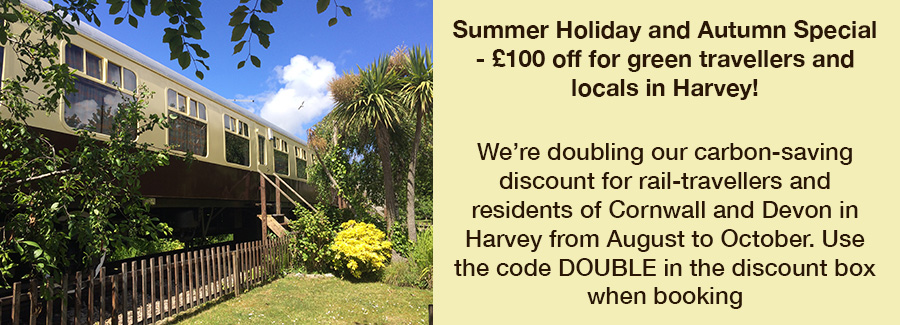
Looe and Polperro
At the end of the Looe Valley branch line, Looe is well worth a visit. It is a typical coastal resort with a pretty working harbour offering fishing trips, a pleasant beach, excellent fish and chip shops and plenty of other shops, restaurants and a couple of amusement arcades. The Cornwall and Devon Rail Partnership often run events on the Looe Valley line. Sit on the left of the train as you leave Liskeard to fully enjoy the splendid vistas as the railway skirts along the lovely Looe estuary, a haven for wildlife and birds. Little Egrets, herons, kingfishers and oyster catchers can be seen enjoying the mud banks created by the low tide.
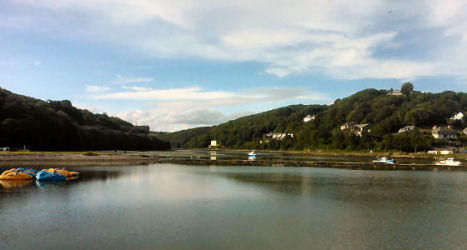

Things to do in Looe
Shop - Looe is great for touristy and quirky gifts and there are plenty of cafes, restaurants and pubs offering a range of food, with an emphasis on fish, the town's
main trade. There is a good bookshop specialising in antiquarian books and several clothes shops.
Enjoy the beach - East Looe has a good sandy beach (no dogs allowed) with step free access, toilets and cafes to hand.
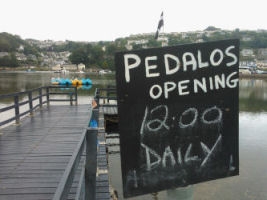

Sea fishing and boat trips - Looe’s working harbour runs parallel with the main street, to the right hand side of the road. Here you can see the fish market, or nearer the beach end book fishing trips on a variety of boats. Sea fishing options usually include searching for mackerel, sharks, deep sea fishing, or just pleasure trips. There are plenty of short trips out around the harbour or around Looe island.
Woodland Walks - Kilminorth Woods across the river from the station is open to the public and accessible through a series of paths.
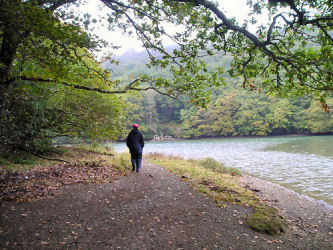
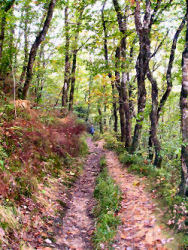
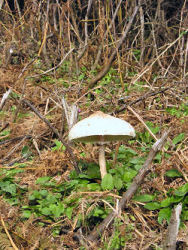
Walk to Polperro along the coast path - An enjoyable walk can be made by crossing the bridge into West Looe, then turning left and keeping the river close on your left. This will lead you onto a footpath which later rejoins the road towards Hannafore Point where there are some good rock pools. Continue to the end of the road and then follow the coastal footpath to Talland Bay, a pleasant bay with sand, rock pools and a pleasant little beach cafe. The footpath continues to Polperro, a very pretty, understandably touristy village with lots of smugglers’ cottages, narrow streets and tiny doorways. It is about three miles from Looe to Talland, and a further mile to Polperro, so with a stop at the beach and a look around Polperro this is a day trip in its own right. There is a bus service between Looe and Polperro so it can be a one way walk.
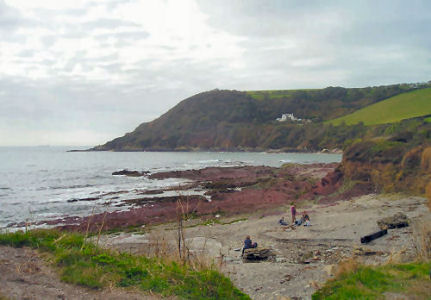

Polperro
Polperro Model Village - including a OO gauge model railway.
The Polperro Harbourside Museum - a very pleasant little museum with plenty of local history and some up to date information on among other things smuggling, knitting, pilchard fishing and manufacture.
Blue Peter - a true local pub serving excellent home cooked food and real ales, with live music from time to time.
Take a look at Looe on our Railholiday Pintrest page.
Menheniot
Menheniot is the perfect destination for a one day trip if you are looking for an action-packed experience! Challenge each other in high speed at Kartworld or ex- perience thrilling adventures at Adrenalin Quarry. Both Kartworld and Adrenalin Quarry are right next to Menheniot Train Station. Because trains are not frequent at Menheniot, you can combine your trip with a bus ride from Plymouth or Liskeard; the stop is on the A38, a five minute walk from the station. Visit www. plymouthbus.co.uk for up to date route information and the latest timetables. Menheniot village is a twenty minute walk from the station and has a medieval church, pub, shop and post office. The St Lalluwy’s Church occasionally has special events and concerts. To see what’s on visit: www.menheniotparish.org.uk
Kartworld How to get there: Walk 10 minutes uphill to the entrance of Kart World. Kartworld offers an exhilarating family go kart racing circuit and they cater for all ages, with custom tracks and go karts for toddlers, children and adults. For further information and prices visit: www.kartworldcornwall.co.uk Adrenalin Quarry How to get there: The entrance is beside the station; walk uphill to reach the main attractions. The Adrenalin Quarry park is safe and fun for families, thrilling for adrenalin junkies. There are multiple attractions on site as well as a play park and picnic area overlooking the lake. The play park and picnic area offer stunning views over the lake where you can bring your own picnic and spread out on the lawn. Or you can order a freshly made picnic or BBQ which you pick up when you get there. There is also a cafe. For further information, opening times and prices visit:www.adrenalinquarry.co.ukLiskeard
Liskeard is an old market town located on the southern edge of Bodmin Moor. The location, right next to the moor, makes it an ideal place to prepare a picnic and head for a walk in the beautiful surroundings. Liskeard made its money from Silver and Tin mining in the Victorian era. One of the greatest charms about Liskeard is that it still is very much a dynamic rural town, with old fashioned outfitters, (visit Gilberts just down from the Market car park), cobblers antique and house clearance shops, lots of cafes and a sense of a community that is still very much alive. A good place to start your exploration of Liskeard is in Liskeard Museum, a charming small museum with a dedicated geology museum and a fascinating collection of photographic memorabilia. Wanting something to do in wet weather? Liskeard Leisure Centre, on the opposite side of town to the station, has a swimming pool, badminton courts and a gym. Visit https://www.better.org.uk/leisure-centre/cornwall/liskeard-leisure-centre
Back in town, Stuart House is well worth a visit, with it's late medieval grandeur and 17th Century Gentleman’s garden. Its most illustrious visitor was King Charles 1, who stayed here in 1644. The house holds a permanent civil war exhibition in honour of his stay. The lower rooms are often used for passing exhibitions and craft fairs and regular concerts take place upstairs. For more information on Liskeard, visit:www.visitliskeard.co.uk. Change in Liskeard for Looe and Looe Valley Line.Bodmin Steam Railway, Bodmin and Lanhydrock House
The Bodmin and Wenford Railway - Discover a journey back in time with the nostalgia of steam travel on the 13 mile round trip from Bodmin Parkway in the Glynn Valley and Boscarne Junction in the Camel Valley. Enjoy the beautiful countryside and find the excitement of
experiencing the era of a Cornish branch line in the 1950s. The line has four stations: Bodmin General, Colesloggett Halt, Bodmin Parkway and Boscarne Junction, all with their own enchanting surroundings to explore. Book tickets for a luxury dining train, steam & cream train or take a steam driving course. For information
on prices, times, special offers and to plan your journey, visit:www.bodminrailway.co.uk The journey is a pleasant steam excursion on a steep gradient line taking in some interesting Cornish countryside on its route, and has a very good gift shop at Bodmin General. From the downside platform cross the footbridge and the steam platform is the one facing away from the mainline.
Once on the railway there are several things to do on the way. At Colesloggett halt a footpath with stiles (muddy in wet weather), leads to Cardinham woods where there are nature trails,
mountain bike tracks (Cycle Hire)and refreshments in the woodland cafe.
At Bodmin General there is a gift shop and cafe, and from here you can catch a train to Boscarne junction which is the start of the Camel Trail cycle\walking trail. A ten minute walk along the trail will take you to the Borough Arms.
To get to Bodmin town, turn out of the station and walk down the hill. In Bodmin there are plenty of places to shop and there is a fish and chip shop at the bottom of the town. Among the attractions in Bodmin is Bodmin Jail, a theme museum for families. This is a former county prison dating back to 1776. The exhibition includes a visit to the dungeons with a historical display of crime and punishment. There is a family play room, shop, tea room and licensed bar.
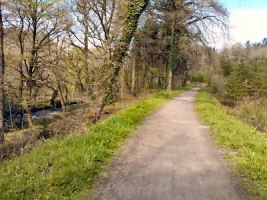 Back at Bodmin Parkway why not visit the award winning Station Café located in the former signal box adjacent to the main station building. It is open most days until 2pm and is operated by the Bodmin &
Wenford Railway and serves a variety of snacks, cream teas and homemade cakes a perfect energy boost before a walk to the beautiful National Trust property of
Lanhydrock. A pleasant two mile walk along the old carriage drive will take you to Lanhydrock House. Go through the burgundy gate at the station car park entrance and follow the lane to its end, beside a lodge house. Go straight across the cross roads, past another lodge house and continue along the tree lined avenue to Lanhydrock House. At the first Lodge House a pleasant diversion can be made by turning left to the bridge which offers good views over the railway, and then taking the clearly marked river walk. There is often an ice cream van in the car park here during the summer months!
Back at Bodmin Parkway why not visit the award winning Station Café located in the former signal box adjacent to the main station building. It is open most days until 2pm and is operated by the Bodmin &
Wenford Railway and serves a variety of snacks, cream teas and homemade cakes a perfect energy boost before a walk to the beautiful National Trust property of
Lanhydrock. A pleasant two mile walk along the old carriage drive will take you to Lanhydrock House. Go through the burgundy gate at the station car park entrance and follow the lane to its end, beside a lodge house. Go straight across the cross roads, past another lodge house and continue along the tree lined avenue to Lanhydrock House. At the first Lodge House a pleasant diversion can be made by turning left to the bridge which offers good views over the railway, and then taking the clearly marked river walk. There is often an ice cream van in the car park here during the summer months!
Lanhydrock House is one of Cornwall’s grandest houses, and is set in beautiful gardens and woodlands overlooking the valley of the river Fowey. It has a restaurant, shop and toilets, and the interior of the house is well worth a visit, if only to look at the fascinating sculptured ceiling and walls of the great hall. The house has been used for several costume dramas. The park is open all year round and extends to nearly 1000 acres.
Lostwithiel
The ancient stannary town Lostwithiel has a rich history and dates all the way back to the 12th century. Its port served at medieval times to export Cornish
Tin and the town hosted Parliamentary soldiers in the Civil War battle of 1644. Today, it is a charming, peaceful market town with a well-known award winning
Friday farmers’ market and numerous antiques shop, vintage fairs and auctions - making Lostwithiel the antiques capital of Cornwall. Take a walk along the tranquil surroundings of the river with stunning views or discover the town’s fascinating history by visiting the compact but fascinating Lostwithiel Museum. Yearly events are
LostFest, Carnival week and Cornish Cider Festival. For more information visit: www.lostwithiel.org.uk A very pleasant walk from Lostwithiel is
to the pretty riverside village of Lerryn passing through St Winnow along the way. This takes in beautiful views of the pretty village of Golant and the river
Fowey. This walk and more can be found at www.lostwithiel.org.uk/walks-and-paths
Farmers Market - Lostwithiel holds a well-known farmers’ market on the 4th Saturday of the month at the Scout hut throughout the year 10am - 1pm. Indulge in locally produced food often sold by the producers themselves. Everything from free range meat and homemade sausages to ice cream, local honey and handmade crafts.
Restormel Castle - How to get there: A 25 min walk from the train station. Directions at:www.lostwithiel.org.uk/walks-and-paths This 13th century circular shell-keep above the Fowey river valley is managed by English Heritage and open April to October. It is a great picnic spot and offers stunning 360-degree views of the surrounding countryside.
Par
Located on the south coast at the edge of ‘clay country’, between St Austell and the Port of Fowey, Par doesn’t really have much of a town centre, but it does make
a good starting point for exploring clay country. The town has exten¬sive docks, built in the 19th century, where china clay is still exported. From here you
can take in the surroundings on a walk between Par and Fowey along the coast through the lush Gribbin peninsula with a white striped beacon and great views of
the coastline. The Atlantic Coast Line starts in Par, with the final stop Newquay, a hugely popular seaside town with 11 golden sandy beaches and some of Europe’s best surfing conditions. From Par a short train journey on the Atlantic line takes you to the historic Luxylyan Valley, a beautiful woodland heritage site with footpaths through old clay works and over the impressive Treffry Viaduct. The bluebells here in late spring are magnificent. For more information visit www.luxulyanvalley.co.uk Check connection times with the main line before planning a day trip along the Atlantic Line, as they are variable:www.great-
scenicrailways.co.uk/lines/atlantic-coast-line
Par Sands Beach - Backed by sand dunes, this beach is popular with families and perfect for a seaside picnic. 15 min walk from Par Train Station.
Type of beach: Sandy / Lifeguard service: No / Dog Friendly: Yes. (Change in Par for Newquay and the Atlantic coastline).
St Austell
St. Austell is often referred to as the capital of the Cornish Alps. The ethereal white mini-mountains, the spoil heaps of the china-clay industry, lend an eerie
atmosphere to the landscape. The clay was discovered in 1755 by William Cookworthy. Kao-Lin, an essential ingredient in the manufacture of porcelain, had
previously only been found in northern China. Today Cornwall still exports clay and the Clay Trails are perfect for a day of walking – combining the cultural
heritage sights of the area with scenes of the extraordinary landscape. For m
more information about local attractions and events visit: www.staustelltown.
co.uk and www.visitthecornishriviera.co.uk
The Eden Project - How to get there: Take the bus from St Austell Station or use the Clay Trail walks and combine it with a visit to Wheal Martyn or a walk to Par. Travel to the Mediterranean without leaving the U.K. Trek through the largest manmade rainforest – steamy jungles, shacks, waterfalls and plantations, with a
tree canopy of almost 50 metres high! First and foremost it’s an enormous tropical garden housed in tropical biomes that nestle in a crater the size of 30 football pitches, but it is also a huge outdoor gallery featuring world class art installations as well as themed events, workshops, activity days, music concerts and an ice rink in the winter. Reduced entry price if you show your rail ticket on the door. For opening hours and more information, visit:www.edenproject.com
Kidzworld - Great for families with young children. How to get there: It is a 15-25 min bus ride from St Austell. Take a 524 or 525 bus in the direction of Par along the main road and get off at Cornish Market World. Kidzworld is an award winning play centre providing over 20,000 square feet of family fun. The majority of the areas are undercover, making this a perfect place to visit even on rainy days. Most of their attractions have no height restrictions on equipment so adults can join in too! For details about prices and opening times, visit: www.kidzworldcornwall.co.uk
St Austell Brewery - How to get there: The Brewery is a short 5-minute walk uphill from St Austell Train Station. Explore St Austell Brewery’s museum
or take a guided tour of their Victorian Brewery and its 21st Century brewing equipment before enjoying a beer tasting. For bookings and opening hours, visit:
www.staustellbrewery.co.uk
The Lost Gardens of Heligan - How to get there: Catch a bus from St.Austell Station directly to the car park. Heligan, a mysterious estate which was
seat of the Tremayne family for over 400 years is now a thriving garden open all year round. Explore over 200 acres grounds with a Victorian garden, romantic
pleasure grounds and a lush subtropical jungle or say hello to some of the estate’s animals: piglets, lambs, chickens, ducks and geese. For more information and
upcoming events visit: www.heligan.com
Wheal Martyn - How to get there: Take the bus from St.Austell Station or use the Clay Trail walks. Wheal Martyn offers 26 acres of woodland walks, nature trails, Cornwall’s largest working water wheel, fully preserved Victorian china clay works machinery and equipment exhibitions. It also houses vintage commercial vehicles and locomotives as well as a children’s woodland play area and a visitor platform overlooking a working china clay pit. For opening hours, admission prices and further information visit:www.wheal-martyn.com
Truro
Truro - Truro is the retail centre of Cornwall with countless stores and independent shops to suit any need. It also offers a wide range of art galleries, the Royal Cornwall Museum and the Plaza cinema hosting many regional premieres, from leading studio pictures to locally produced works. Stroll down the streets while admiring the Georgian architecture or visit the magnificent Truro Cathedral – the big heart of the city centre. The area also offers a wide range of excellent cycling
trails and a lot of events throughout the year. For more information visit:www.visittruro.org.uk Royal Cornwall Museum - How to get there: A 10 minute walk from the train station; follow the road down the hill and head towards the city centre. Visit the Royal Cornwall Museum to find out more about Cornwall and its history
as well as to admire a wide range of Cornish and British art. The natural history gallery shows the plants and animals of Cornwall and on permanent display is an
exhibition of St Ives art from 1840-1940 and an internationally remarkable mineral collection with over 1200 specimens, including the largest crystal of Liroconite
ever found! Each gallery has child-friendly exhibits and the museum has a full schedule of activities, lectures and talks throughout the year. Children (age 18 and under) visit for free and adults pay only once for a year’s pass. For opening hours and prices visit:www.royalcornwallmuseum.org.uk
Truro Cathedral - How to get there: The Cathedral is located in the centre of Truro, the Cathedral of the 'Blessed Virgin Mary' is without doubt the enticing landmark defining the city’s character with its majestic three spires. In fact, it is one of only three cathedrals in the United Kingdom with three spires. It looks like a medieval building but is actually late-Victorian, built in 1880, where they decided to adapt the classic pointed arches of Gothic architecture using modern building techniques to create it. Truro Cathedral hosts many events and concerts throughout the year, to see what’s on and to find out opening hours and services visit: www.trurocathedral.org.uk
Trelissick Gardens - How to get there: Catch a bus from the stop at Lemon Quay in the centre of town or take the passenger ferry from Truro, St Mawes or Falmouth during high season:April – September. The information and ticket centre for ferries is at Garras Wharf, through the underpass from Lemon Quay. Trelissick Gardens is set on its own peninsula next to the River Fal - an outstanding location for stunning views with an 40-acre waterside garden and a 300-acre estate
with countryside, parkland and woodland offering fantastic trails for walkers along the riverside. The parks and walks are open all year every day. For information on prices and to see upcoming events and activities, visit:www.nationaltrust.org.uk/trelissick.
Just a short train ride from Truro is the charming harbour town of Falmouth, a cultural centre for art, crafts and performances with beautiful beaches and great sea food restaurants. (You need to change trains at Truro to get to Falmouth). Or if you're in the mood for waves and a pleasure trip down Truro River? Then Catch a passenger ferry to the charming harbour town of Falmouth with golden beaches and Maritime Museum or to picturesque St Mawes. Regular ferry services run from Town Quay, only a short walk from the city centre. For travel details, visit:www.falriver.co.uk
Redruth
Redruth, once the urban centre of the Cornish Mining industry, is now at the heart of the World Heritage Site. It is set in a dramatic valley between Carn Brea,
Carnmenellis and Carnmarth and this was the largest and richest metal mining area in the UK during the 19th century with mining heritage dating all the way back to the Bronze Age. The town’s architecture is defined by this heritage, with grand Victorian houses and miners’ cottages. During the summer months, the town hosts several continental markets. At the centre of the Mineral Tramways there are trails which cross the Mining World Heritage Site offering breathtaking views of the Cornish north coast, making the surroundings extraordinary for cycling, horse riding and walking. Catch a bus to the nearby picturesque coastal village of Portreath to enjoy the popular sandy beach or have a full day of nature adventures at Feadon Farm. The remnants of the once bustling mining industry are ever present in Redruth
and its surrounding landscape and there are a number of Town Trails you can walk to explore the historic sites around the centre of town. To download maps and find out more about Redruth and its heritage and surroundings, visit:www.visitredruth.co.uk
Feadon Farm - Feadon Farm Regal Cinema and Theatre - How to get there: Catch a bus from Redruth to Portreath. If you want to get up close and personal with nature, Feadon Farm Wildlife Centre is the place to go. It is a wildlife wonderland offering numerous activities, woodland experiences and beach adventures. You can join their Wildlife Ranger for a woodland safari, feed and cuddle reindeers and foxes or even go for magical night walk with their expert guide. Booking is required for all activities and you can tailor your visit to suit your needs. Book a half- or full day experience or a specially customized trip, whatever suits the ages, interests and physical capabilities of your group – there is something to enjoy here for everyone. For detailed information and bookings, visit:www.feadonfarmwildlife.co.uk
Regal Cinema and Theartre - How to get there: Head to the town centre. The Regal is a 3 min walk from the train station. One of the most popular cinemas in
Cornwall, the Regal Cinema and Theatre plays an important part of Redruth’s cultural scene. It is located at the heart of the pedestrianised Murdoch Quarter and boast a stage for theatre performances as well as numerous screens for all the latest blockbusters. The Regal also has a bar and restaurant with indoor and outdoor seating.
Cycle Redruth to St. Ives – ‘The Coastal Trek’ - This cycle route takes you from Redruth out along a coastal route to St.Ives. The route is mainly along country lanes and B roads. Directions are available at:www.cycleroutesuk.com Distance: 19 miles (30.5 km).
Camborne
Together with Redruth Mining District, Camborne was at the heart of Cornwall’s former tin mining industry and has now been designated a World Heritage Site. Camborne was also the home of engineer Richard Trevithick, honored in April every year at the Trevithick Day festival. The mining roots of Camborne are still evident with chimney stacks and the characteristic flora and fauna of the Cornish mining landscape. The Red River, named as a result of the water colour caused by mineral from the mines, runs through the award winning parkland Tuckingmill Valley Park, with its bespoke skate park
and creative art installations. Enjoy a free day of family fun at Heartlands – a 19 acre visitor attraction and World Heritage Site Gateway. Alternatively explore the largest woodland area in West Cornwall – Tehidy Country Park. For more information, visit:www.cornwalls.co.uk/Camborne
Heartlands - How to get there: It is 30 minute, 1.5 mile walk from Camborne Train Station along the main Camborne to Redruth road. Alternatively, catch a bus from Camborne or Redruth. Heartlands is Cornwall’s first free cultural playground, with 19 acres of family fun to explore. Green outdoor spaces for warm, sunny days as well as an intriguing indoor space make it an all year round, all weather entertainment with exhibitions, climb-on sculptures, botanical gardens, a giant adventure playscape for kids and art and craft studios. Heartlands offers a diverse events programme throughout the year with farmers markets, cultural festivals, dance shows, music events, art exhibitions and theatre. To find out what’s on and for details on opening hours, visit:www.heartlandscornwall.com
Tehidy Country park - How to get there: Buses run regularly from Camborne Train Station to Tehidy Park.
Alternatively, walk from the station approx. 45 mins. Tehidy is a 250 acre country park, the largest area of woodland in West Cornwall, with woodland, lakes and ponds. There are 9 miles of footpaths to explore as well as a picnic area and popular café. Take a look at the Basset memorial on the prominent hill at Carn Brea, built in 1836 to honor Sir Francis Basset, or simply stroll around the lake to immerse in the rich flora and fauna of the area and enjoy a moment of tranquility.
The park is free to enter and dog friendly all year round.
Tuckingmill Valley Park - How to get there: It’s an approx. 25 min walk from Camborne Train Station along the A3047 towards Redruth. Tuckingmill Valley Park is an outstanding, award-winning parkland, a symbol of regeneration for the area that has become a centre of excellence in conservation. The facilities include a skate park,numerous walking trails, play facilities and creative art installations – all with careful consideration of the regional flora and fauna. The park has transformed the valley while still managing to maintain the symbols of Cornish mining landscape and the signature plants and habitats associated with this environment. The conservation tasks of the park are coordinated between The Conservation Volunteers, the Council and the community. To find out more about the park, visit:www.tcv.org.uk/tuckingmill
Hayle
Hayle is situated on the opposite side of St Ives Bay. Try exciting water sports like surfing, snorkeling, diving and sailing The hugely popular Gwithian beach offers
excellent conditions for surfing and Hayle Towans Beach and Godrevy beach makes for a relaxing, family friendly day out. The surroundings are perfect for walking,
with plenty of well-marked footpaths and trails. The area is also regarded as an international quality bird-watching spot. During the industrial revolution, the
copper smelting contributed to the construction of the town’s harbour and townscape, giving it World Heritage Site status in 2006. Hayle is also famous for its pasties, with Hampsons, Warrens and Philps all vying for the top spot. A lovely walk from Hayle station is along the track bed of the old Hayle Wharf railway. Take the cycle path that leads behind the up-bound platform. When you reach the path’s end, cross the road and walk over the sluice gate bridge. From here you can stroll along the harbour to Hayle’s beaches, or turn right beside the open air swimming pool to the promenade along King George’s Memorial Walk; an extravaganza of tropical plants and sensory gardens running alongside the estuary. For more information about Hayle, visit:www.hayletown.co.uk
Paradise Park - How to get there: A 10 min walk from the train station. Walk down the hill to Foundry Square. Take the Helston Road and follow the brown signs, turning right when you get to the top of the hill. Paradise Park is a wildlife sanctuary and indoor play centre. It is home to a range of more than 650 tropical birds and other animals in their ‘Fun Farm’. The indoor play area has giant slides and a special toddlers’ area. For opening hours and prices, visit:www.paradisepark.org.uk
Beaches - With its extensive stretch of golden, sandy beaches, the surroundings of Hayle has something to suit everyone.
Gwithian Beach & Godrevy are hugely popular with locals and holiday makers and this surfers’ paradise is the place to go if you want to get a lesson from the local surf school or hire wet suits and surf boards. Godrevy owned by the National Trust, is connected to Gwithian Beach at low tides and end at Godrevy Point with beautiful Godrevy Lighthouse. The beach is popular for families and surfers as well as for walkers and nature watchers with the surrounding alluring headlands.
Type of beach: Sandy / Lifeguard service: Yes (seasonal) / Dog Friendly: No dogs allowed May to October, inclusive.
Hayle Towans Beach - Towans is the Cornish word for dunes and this wide stretched sandy beach is slightly sheltered from the Atlantic waves and rarely gets crowded even in the most busy summer days. Type of beach: Sandy / Lifeguard service: Yes (seasonal) / Dog Friendly: No dogs allowed May to October.
St Erth
The Cornish rural village of St Erth is situated in West Cornwall, on the River Hayle. It is the starting point for the St Ives branch line, which is a scenic railway
with spectacular sea and estuary views. St Erth’s surrounding countryside offers a wide range of walking, cycling and riding trails as well as several local golf courses. St Erth is home to one of the finest ancient bridges in Cornwall, now over six hundred years old. The village also has a shop, a post office, The Star Inn pub and two churches. For more information on local events and concerts held by the churches, visit:www.st-erth.co.uk
Farmers Market - St Erth holds a Farmers’ Market every Saturday at the Methodist Hall from 10am to noon. A variety of local produce is on sale, such as flowers, crafts, cakes, fresh fish and meat, bread, pasties and other home cooking. The branch line to St Ives has an excellent service, with half hourly trains, allowing
easy access to the pretty village of Lelant, the coastal footpath and of course St Ives; famous for its special quality of light that for years has drawn artists to live in the area. Here you can visit the Tate Modern and Barbara Hepworth’s sculpture garden, take fishing and pleasure boat trips to watch seals and other wildlife or just enjoy an ice-cream on one of St Ives sandy beaches. (Travelling by train change in St Erth for St Ives and St Ives branch line).
Penzance
Penzance is a coastal town defined by it's history, providing top quality attractions of ancient sites as well as a variety of nearby beaches to enjoy on sunny days.
Take a stroll along the town’s seafront, lined with palm trees or indulge yourself in an all-day shopping frenzy. The town is surrounded by an area of
magnificent natural beauty and Celtic culture, only 9 miles from the impressive scenery of Land’s End. A few miles away at Porthcurno the stunning Minack Theatre offers a great seasonal cultural scene, hosting live performances and music concerts in the summer. A visit to the island castle of St Michael’s Mount is a must with its enchanting castle and tropical garden. Alternatively walk or take the bus towards the picturesque fishing villages of Newlyn and Mousehole, with their thriving arts scenes and in winter fabulous Christmas light displays. For more information about what Penzance has to offer, visitwww.penzance.co.uk
St Michael’s Mount - How to get there: Catch a bus from Penzance Train Station to Marazion or walk to Marazion, 2.1 miles (3.4 km). St Michael’s Mount with it’s cobble streets, enchanting medieval castle and tropical garden will dazzle you. Still home to the St Aubyn family and a small community, the charming island offers visitors the chance to explore the island’s legends, architecture and thousand years of history, with buildings dating all the way back to the 12th century. Stray from the mainland across the granite causeway in low tide, following the foot-steps of pilgrims, or catch a boat in high tide. Relax in the vivid subtropical garden and explore the ancient castle and church at the top. Have a picnic, tuck into fresh local food at Sail Loft Restaurant or indulge in a cream tea at the Island café.
For detailed information regarding tide timings, opening hours and boat ticket fees, visit: www.stmichaelsmount.co.uk
The Minack Theatre and Porthcurno Telegraph Museum - How to get there: Catch a bus from Penzance to Porthcurno or buy your ticket through one of the travel operators that arrange inclusive trips to the theatre which can include pick-ups from Penzance or St Ives. The Minack Theatre is a world famous open-air cliff theatre, constructed in the 1930s, overlooking the spectacular panorama of Porthcurno Bay. Its performances runs throughout the summer season presenting drama, live music, opera and musicals. Day visitors can explore the subtropical garden, relax in the café, and enjoy a matinee or children’s story telling performance. In evenings, the atmosphere of the performances are magically enhanced with the sea and moon. Performances are from June to September but the visitor centre, gardens and café
are open year round. For more info, visit www.minack.com Porthcurno Telegraph Museum celebrates Porthcurno’s location as the point at which many transatlantic submarine telegraph cables came ashore. The museum is housed in the former telegraph facility. This excellent attraction has a host of fascinating displays, guided talks and a chance to dress up in Victorian clothes or practice Morse code, a historic tunnel, and a sculpture garden. For more information visit: www.porthcurno.org.uk
Ferry to the Isles of Scilly - The Isles of Scilly, just off the coast of Cornwall, with their astonishing, unspoiled beauty and golden sandy beaches,
are loved by locals and visitors alike. The exceptionally mild climate and peaceful atmosphere make them a haven of tranquility and you can walk and hike, cycle
or enjoy boat trips and tours to explore the islands and their remarkable wildlife. The ferry departs from Penzance to St Mary’s Harbour. It is also possible to
travel by aeroplane from Lands End, Newquay or Exeter. Plan your trip and find out more on: www.visitislesofscilly.com
Beaches - The area around Penzance has dozens of beaches and the examples below are all accessible by bus; the bus station is adjacent to the train station in Penzance. Penzance Beach - The beach in Penzance stretched along the Promenade for a mile and is only accessible from mid to low tide. Type of beach: Shingle and rock / Lifeguard service: No / Dog Friendly: No dogs allowed between Easter to October inclusive. Porthcurno Beach - With its white sand and clear waters,
Porthcurno beach looks tropical and is described by some as being a paradise set in an idyllic cove. It is popular with both tourists and locals and it is situated
on the cliffs right below the famous Minack Theatre and Porthcurno Telegraph Museum. Type of beach: Sandy / Lifeguard service: Yes (seasonal) / Dog Friendly: No dogs allowed May to September inclusive. Marazion/Longrock Beach - Marazion Beach is a popular family beach with a good children’s playground located on the green behind. After the mile long beach of Marazion the bay becomes Longrock Beach, another safe family beach where swimming is particularly safe. Type of beaches: Sandy / Lifeguard service: Yes (seasonal) / Dog Friendly: Marazion: No dogs allowed Easter to October (inclusive) / Longrock: Dogs allowed all year. Sennen Cove Beach
With its excellent reputation as a surfing venue, Sennen Cove Beach is a long, sandy beach extremely popular with a laid back surf style and friendly atmosphere.
Type of beach: Sandy / Lifeguard service: Yes (seasonal) / Dog Friendly: No dogs allowed May to September, inclusive.
Lands End - How to get there: Catch a bus from the Penzance station to Land’s End. Land’s End, only 9 miles west of Penzance, is the most westerly point of the
English mainland and the closest to the North American continent. With stunning, natural beauty and outstanding wildlife, it is the perfect place for walking along the wide stretched, cliff covered coastline. You can see the famous Longships Lighthouse only a short walk from the visitor centre and even the faraway silhouettes of the Isles of Scilly will bevisible in the far distance on clear and sunny days. Explore the extraordinary scenery on trails available in guides from the visitor centre. To plan your trip, visit:www.landsend-landmark.co.uk
Back to TOP
Contact Railholiday by email at office@railholiday.co.uk or by phone on (+44) 01503 230783. ©



